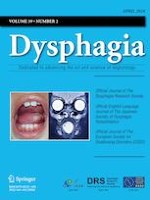Erschienen in:

16.08.2023 | Original Article
Temporal Characteristics of Penetration and Aspiration in Patients with Severe Dysphagia Associated with Lateral Medullary Syndrome
verfasst von:
Meng Dai, Jiao Qiao, Huayu Chen, Zhonghui Shi, Binbin Liu, Zu-Lin Dou
Erschienen in:
Dysphagia
|
Ausgabe 2/2024
Einloggen, um Zugang zu erhalten
Abstract
To assess the severity and timing of penetration and aspiration (PA) of severe dysphagia after lateral medullary syndrome (LMS) and its association with temporal characteristics. We performed videofluoroscopic swallowing studies (VFSS) in 48 patients with LMS and severe dysphagia and 26 sex- and age-matched healthy subjects. The following temporal measures were compared between groups: velopharyngeal closure duration (VCD); hyoid bone movement duration (HMD); laryngeal vestibular closure duration (LCD); upper esophageal sphincter (UES) opening duration (UOD); stage transition duration (STD) and the interval between laryngeal vestibular closure and UES opening (LC-UESop). The association between temporal measures and Penetration–Aspiration Scale (PAS) scores was analyzed. Differences in timing measures were compared between subgroups (safe swallows, and swallows with PA events during and after the swallow). PAS scores ≥ 3 were seen in 48% of swallows (4% occuring before, 35% occurred during and 61% after the swallow) from the LMS patients. Significantly longer STD and LC-UESop were found in the patients compared to the healthy subjects (p < 0.05). Significant negative correlations with PA severity were found for HMD, LCD, and UOD. Short UOD was the strongest predictor with an area under the receiver-operating-characteristic curve of 0.66. UOD was also significantly shorter in cases of PA after the swallow (p < 0.01). Patients with LMS involving severe dysphagia exhibit a high frequency of PA (mostly during and after swallowing). PA events were associated with shorter UOD, HMD, and LCD. Notably, shortened UOD appears to be strongly associated with PA.